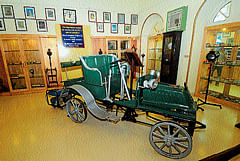
With rapid modernisation, an integral part of our culture today, lives only in the stories told to us by our grandmothers. However, 'Aloyseum,' the museum of St Aloysius College is all set to give people a taste of the by-gone era.
The century old museum was renovated and re-inaugurated by St Aloysius Institutions Rector Rev Fr Joseph Rodrigues SJ on Saturday.
The museum displays antiques and artifacts in four rooms. Some of the items displayed even date back to the stone age, such as stone tools, leaves and twigs from trees which are over 2500 years old.
The museum has four rooms. The first room is dedicated to musical instruments. Old gramophones, vinyl discs, Mangalore's first brass band, piano, harmonium, accordion, radios and a wide range of cameras are displayed here.
Another room consists of wooden artifacts used by our ancestors to do the household work and also old machines.
The roof of this room is adorned with a huge whale bone. Skulls, horns and skins, copies of paintings by old European masters, mineral specimen, telegraphic equipment, antique telephone sets, manuscripts on palm leaves, Portuguese statues, an old pulpit from Cordel Church, swords, daggers, bullets and other weapons, postal stamps, coins and medals and Mangalore’s first electric generator dating back to 1930, bullock cart and an old bicycle give us a glimpse of our past.
One of the showcases displays priestly vestments dating back to 1878, the Old Missal, displayed alongside, which has the size of a broad sheet newspaper could weigh several kilos is another major attraction.
M'lore's first car
One of the more visible exhibits is a De Deon automobile, the first to land in Mangalore. It was imported by P F X Saldanha of Highland Coffee Works fame. When it landed in Mangalore in 1906, it attracted large inquisitive spectators wherever it went.
But, it didn’t venture out much because of scarcity of petrol. As there were no petrol stations in Mangalore then, the liquid had to be brought from Madras in 10- gallon drums and under special license. In 1907, when Governor of Madras, Sir Arthur Lawley, visited Mangalore, the De Deon was lent to the Governor’s party to take his two daughters to Karkala to see Gomateshwara. The Governor wrote to Saldanha thanking for the favour.
This single-cylinder, 8 / 10 hp car had a maximum speed of 19 miles. It had an open top, but in 1920 it was fitted with a hood over the front seats. It was gifted to the college in 1956, without its engine.
Berlin Wall
Another main attraction are pieces of Germany's Berlin Wall, which was destroyed in 1990.
The pieces were collected by Veteran Scientist, Rev Fr Leo D'Souza SJ, who was in Berlin during the incident.
Speaking to Deccan Herald, Fr Leo said that he witnessed the incident and picked up pieces of the demolished wall. Today, in Aloyseum they tell history, he said.
Future plans
Speaking to Deccan Herald, College Principal Rev Fr Swebert D'Silva SJ said that the museum was renovated at a cost of Rs 80 lakhs of which Rs 25 lakhs was given by the Central Government.
"We have plans to make Aloyseum, a Mangalore museum which gives us a complete picture of Mangalore's culture. We shall soon add a section of various cultural attire worn by people of Mangalore," he added.
The renovation work started last year. Michael J M Cutinha has been appointed as the Museum Curator. A nominal fee is charged, which will be used to maintain the museum, he added.
About Aloyseum
The museum had a humble beginning in the Red Building in 1913 with the items brought from Italy by Fr Chiappi. He brought minerals and herbarium and a collection of Roman coins and commemorative medals. Some of them were gifts from Collegio Vieta, Italy.
In 1927, Fr Prosperio who was the Rector, provided a hall for the museum. In 1944, the museum was shifted to Chettur’s Bungalow at the eastern end to the campus. Incidentally, the starting of natural science courses in the college in 1943 gave a boost to the museum. In 1947, it shifted again – this time to English Hall. In 1955, when Fr Albert Saldanha was the Rector, he got the museum rearranged in New Extension.
The next move came in 1995 when the then Principal of the college, Rev Fr Prashant Madtha, initiated action to rehabilitate the collection in a new setting.
So, the museum completed a full circle going back to the Red Building where it had taken birth 82 years earlier. It was during that time, the name 'Aloyseum' was coined by Professor R Victor, Head of the Department of English.
St Aloysius Chapel and Aloyseum attracts a large number of tourists, especially foreigners.